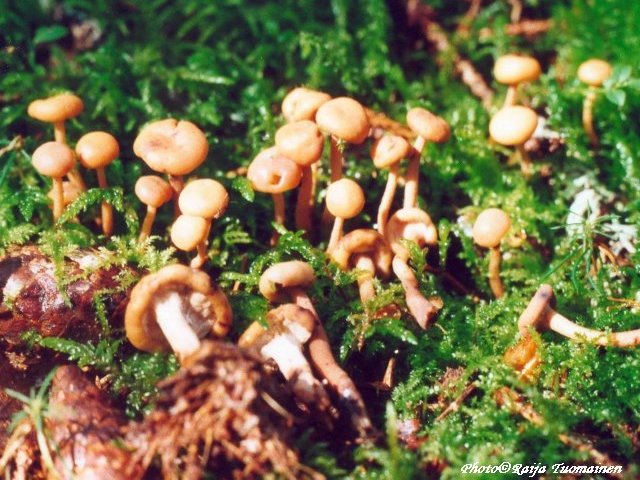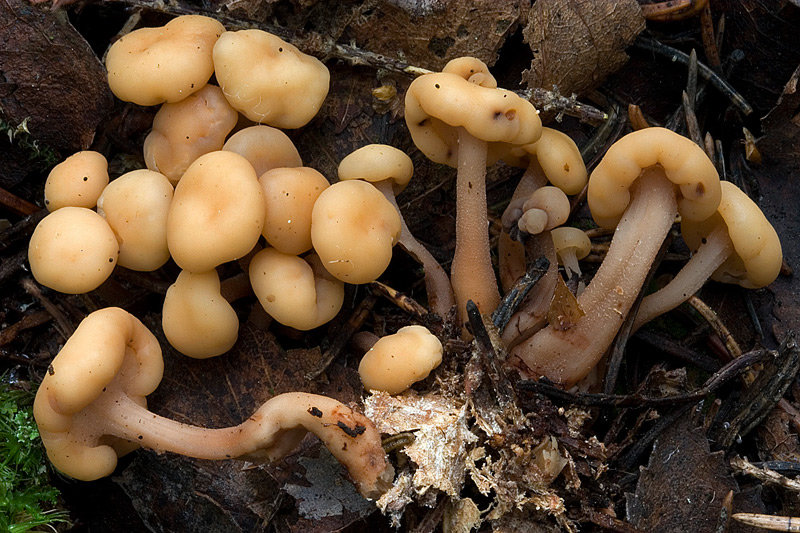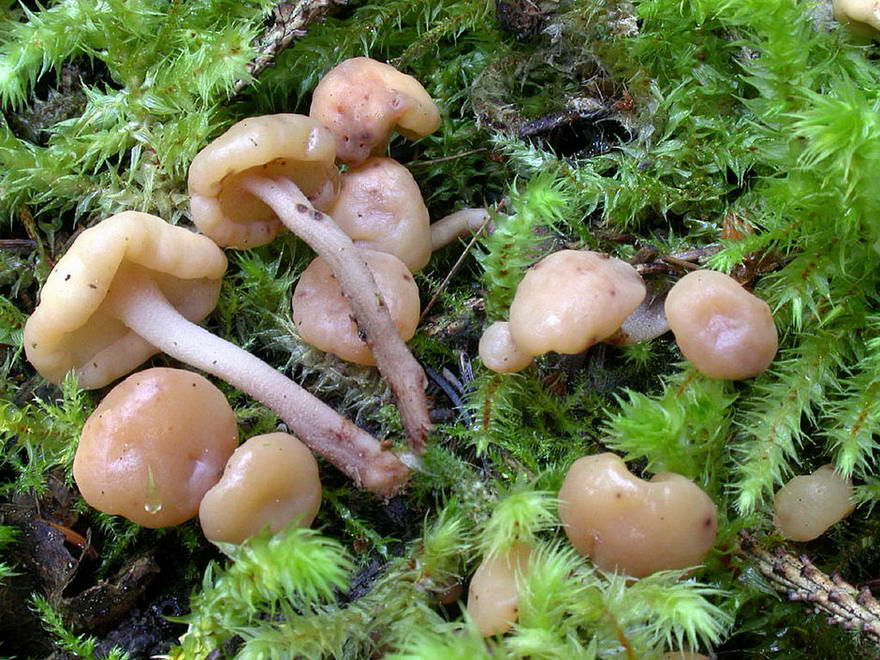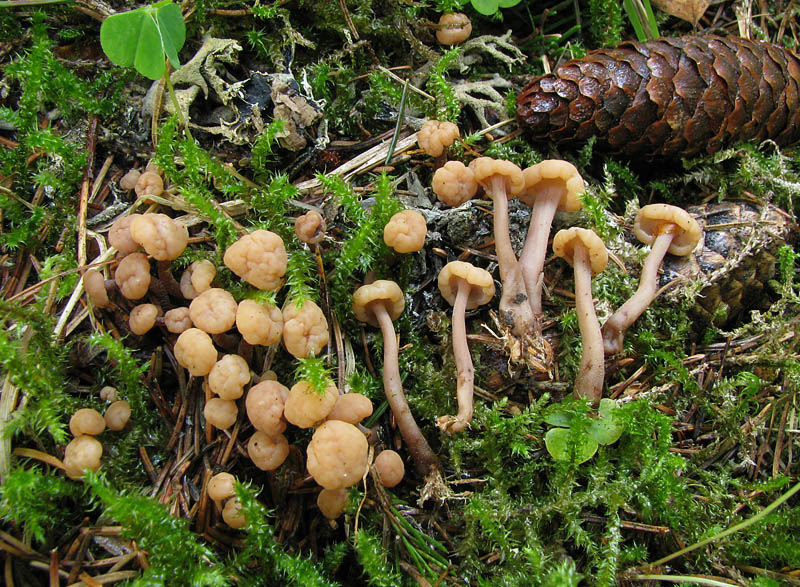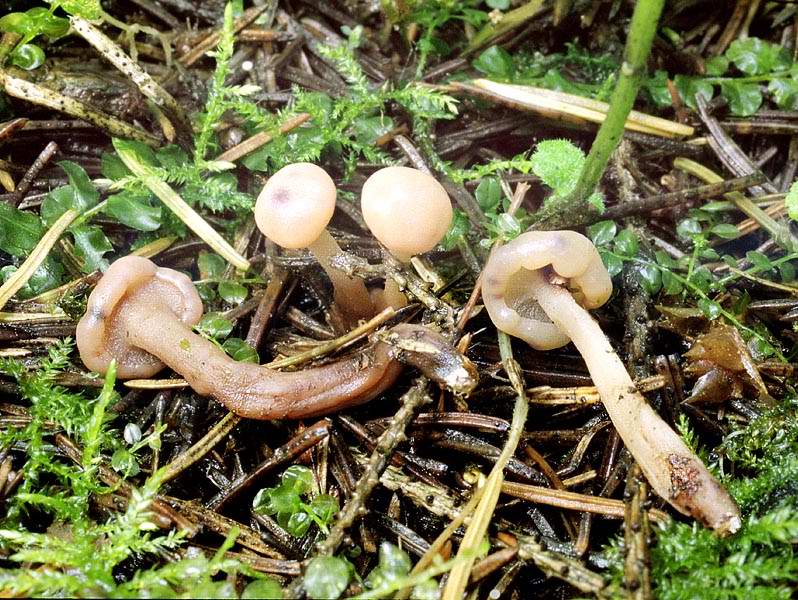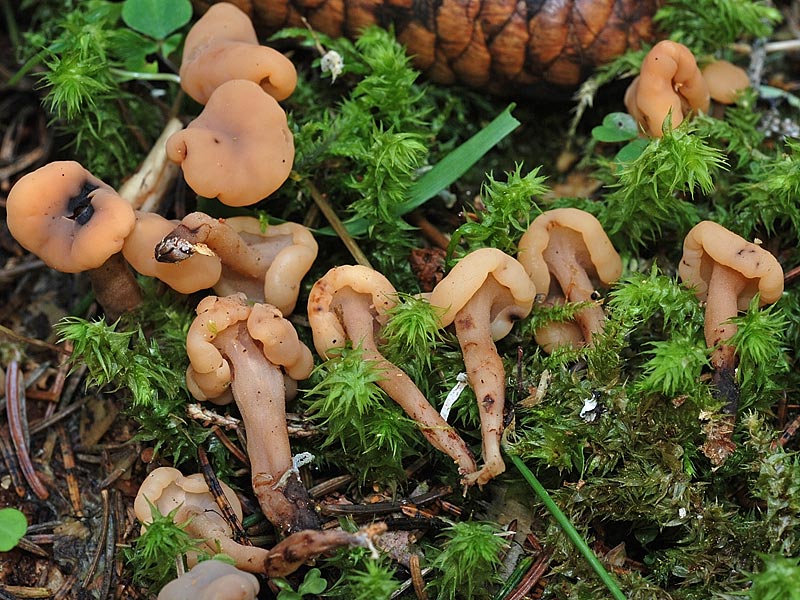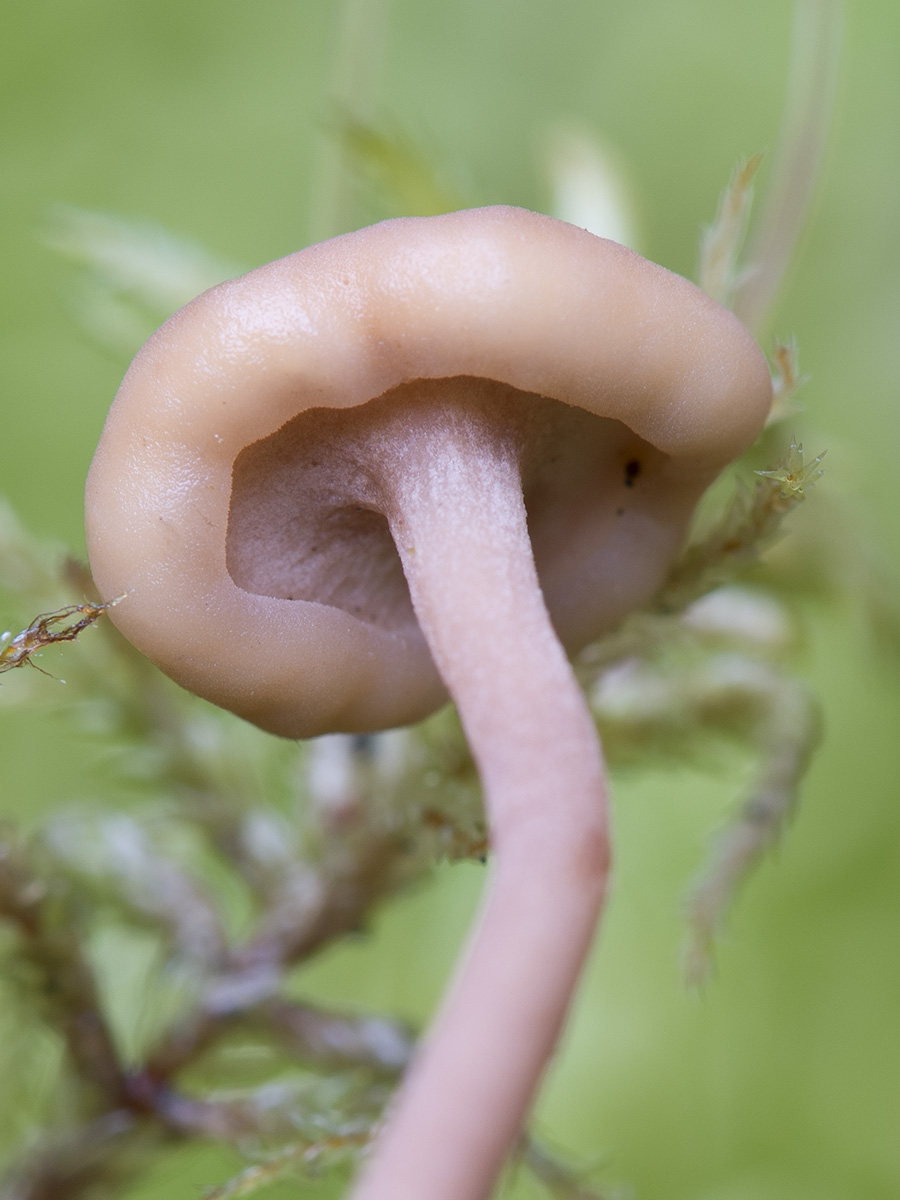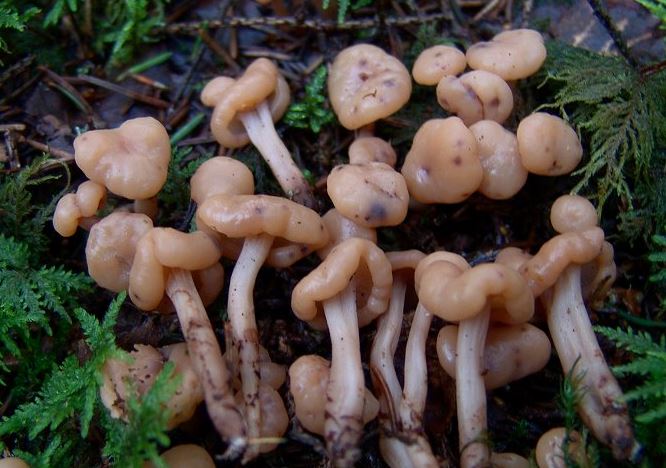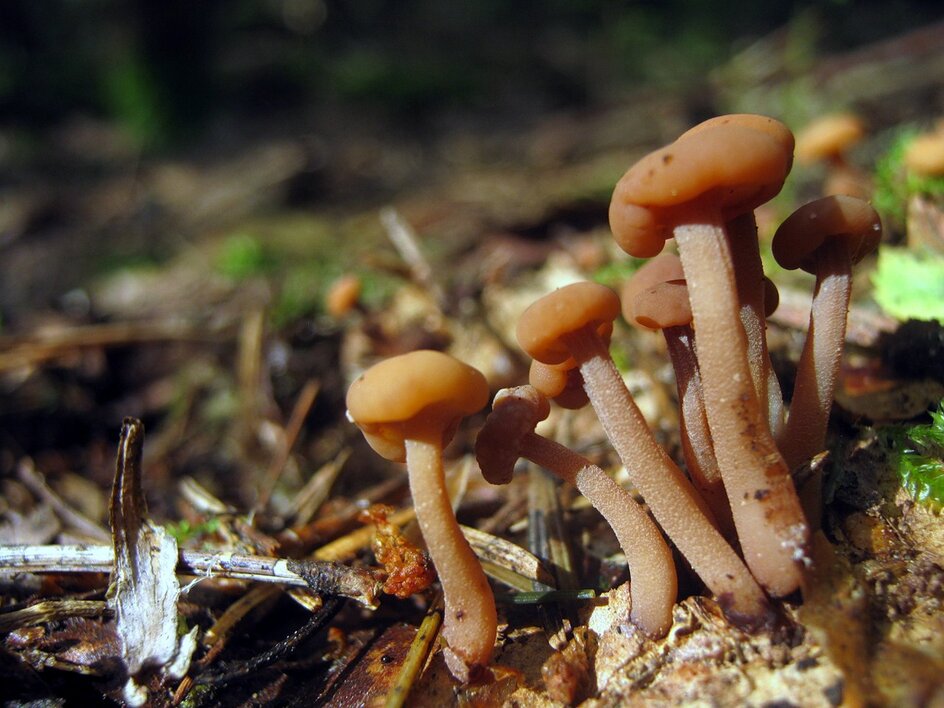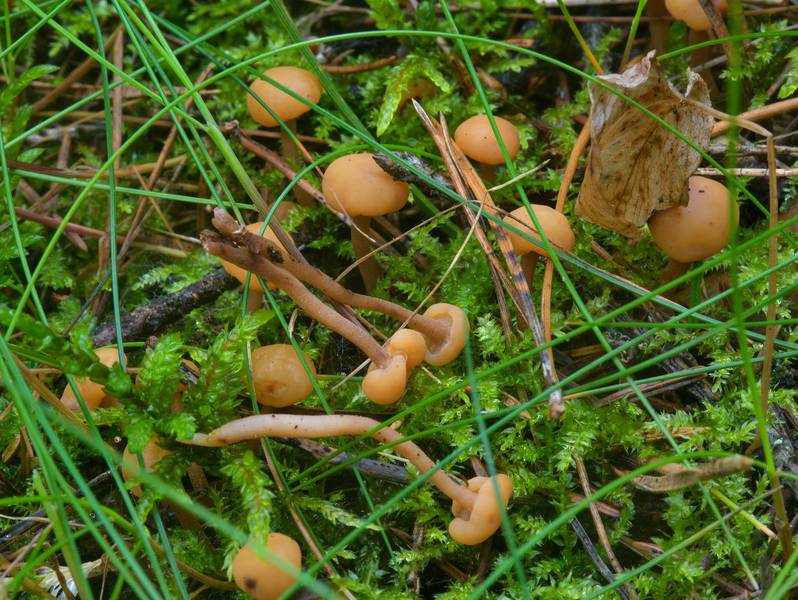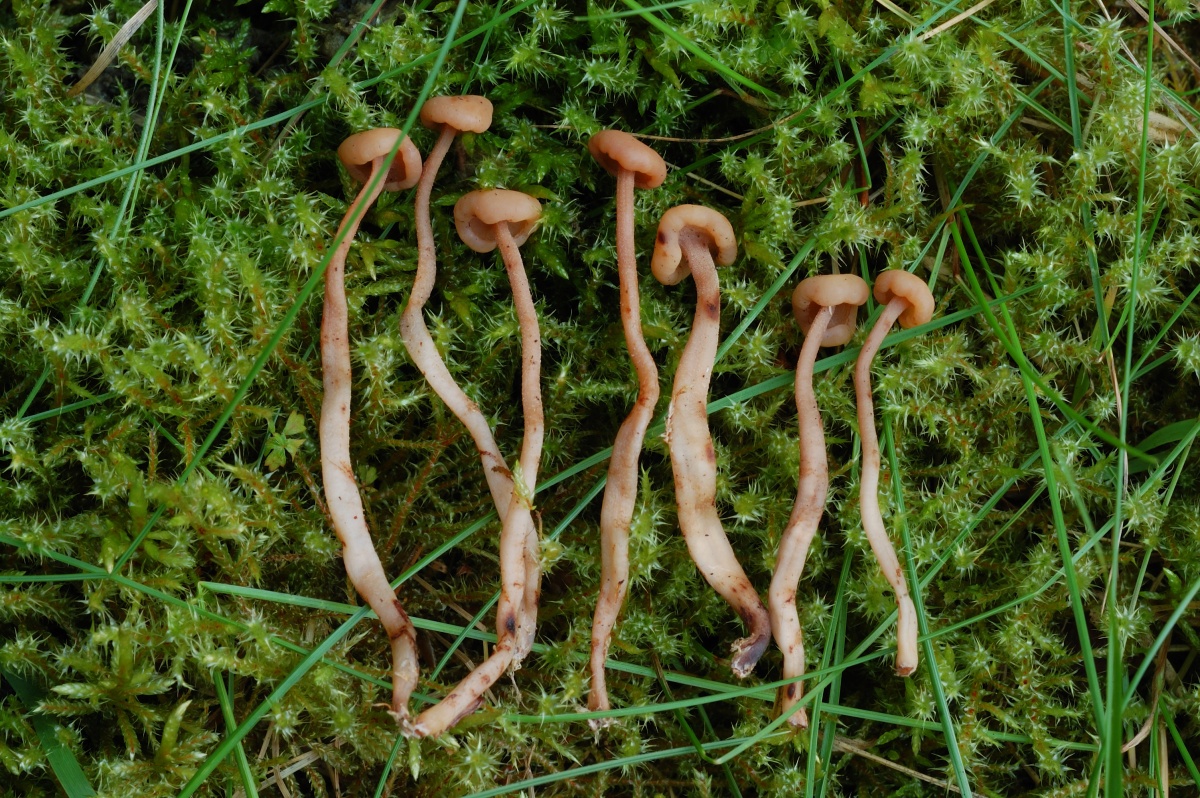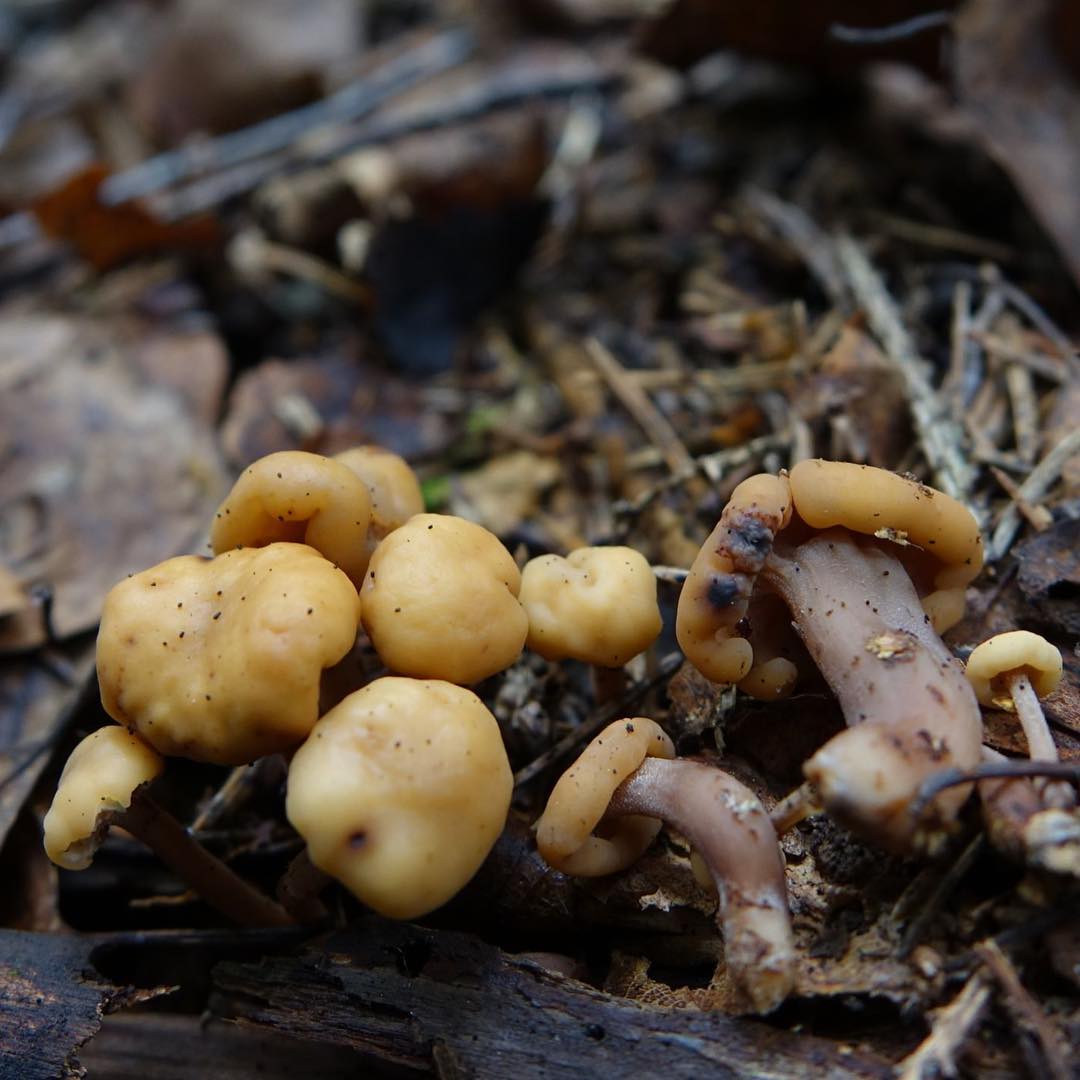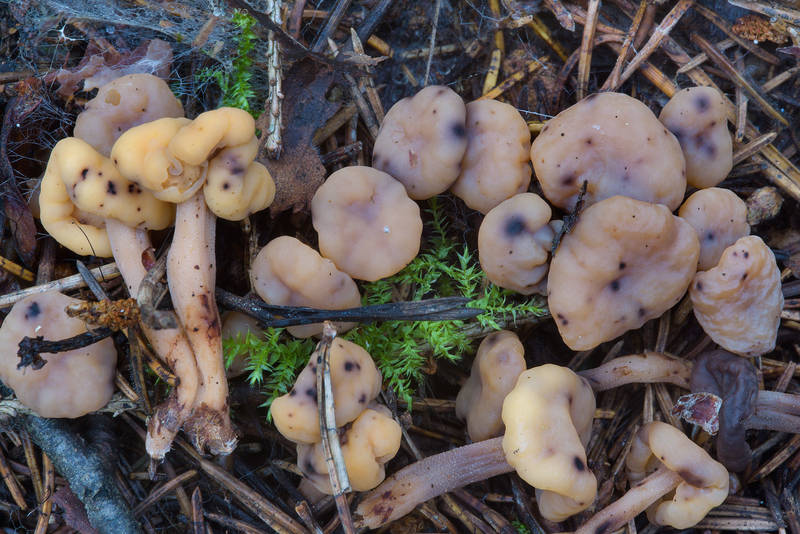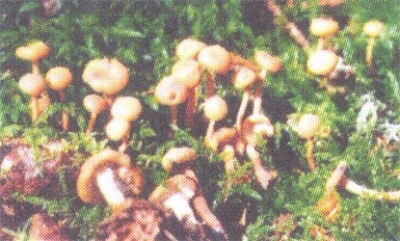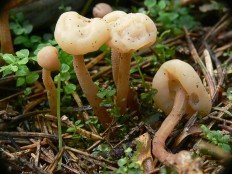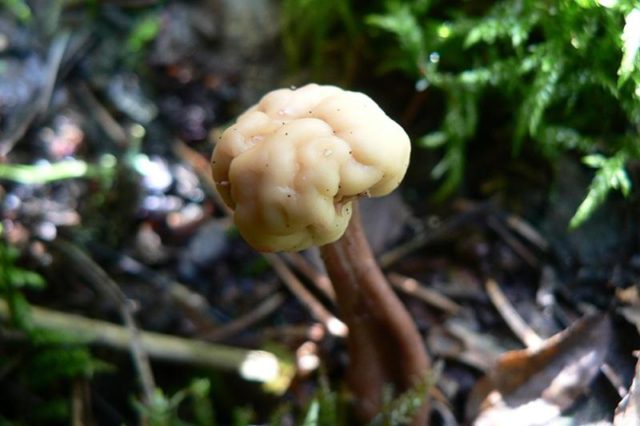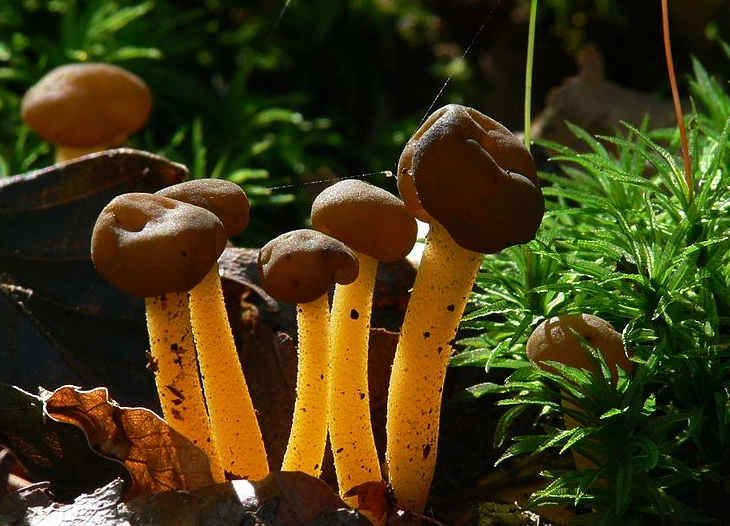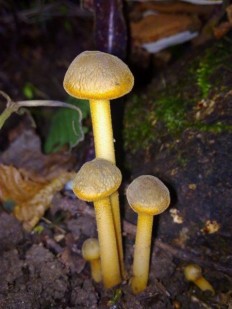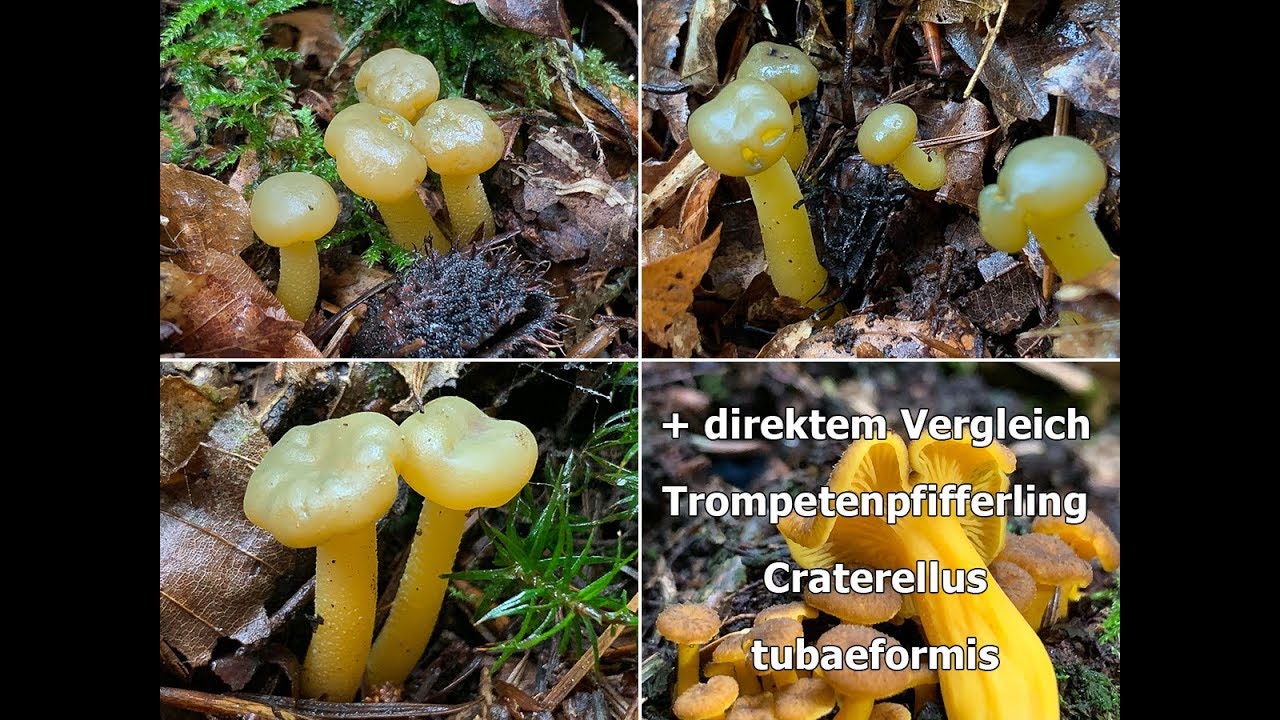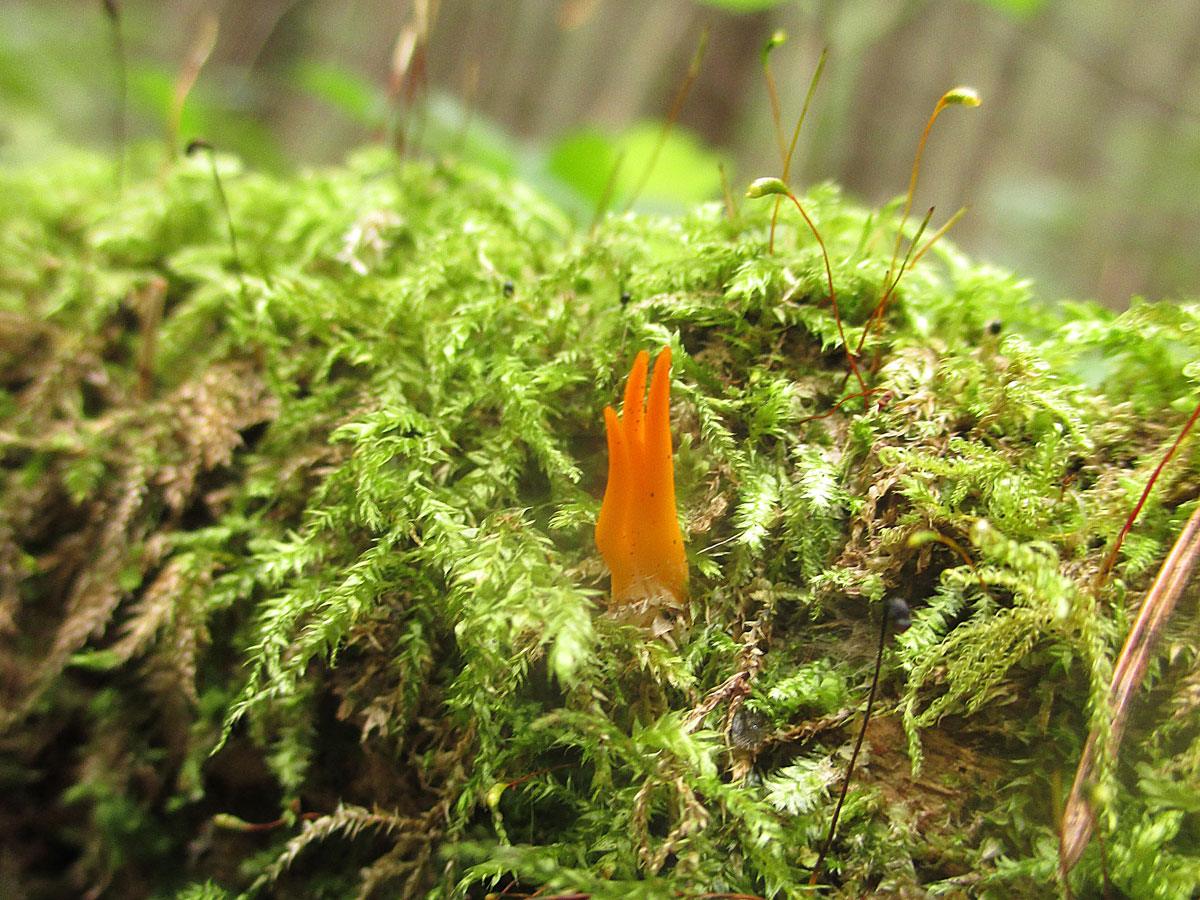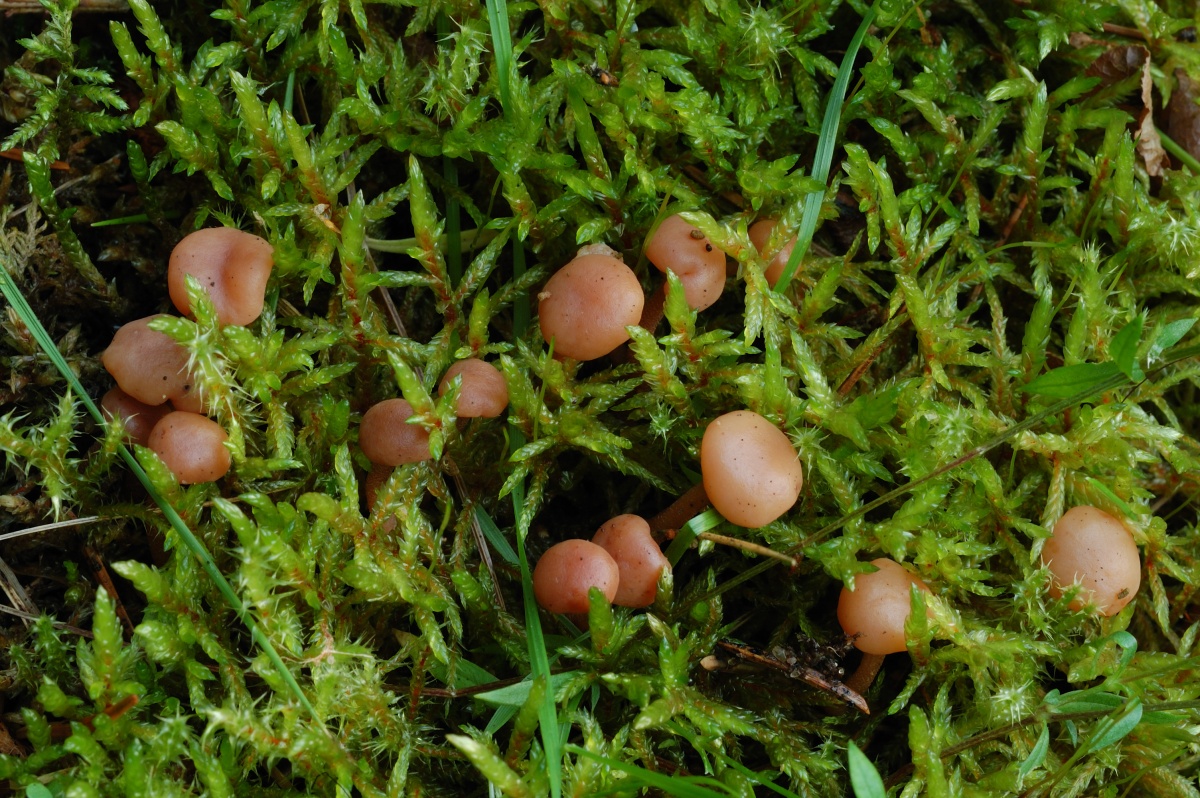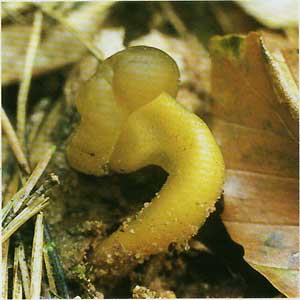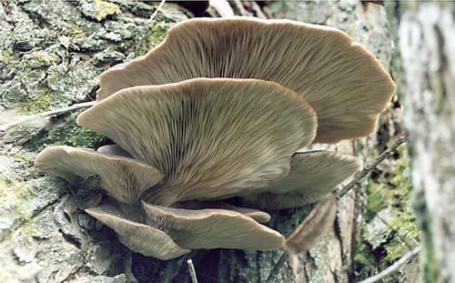Spotted pucciniastrum (Pucciniastrum areolatum)
Synonyms:
- Licea strobilina
- Melampsora areolata
- Melampsora padi
- Perichaena strobilina
- Phelonitis strobilina
- Pomatomyces strobilinum
- Pucciniastrum areolatum
- Pucciniastrum padi
- Pucciniastrum strobilinum
- Rosellinia strobilina
- Thecopsora areolata
- Thekopsora padi
- Thekopsora strobilina
- Xyloma areolatum
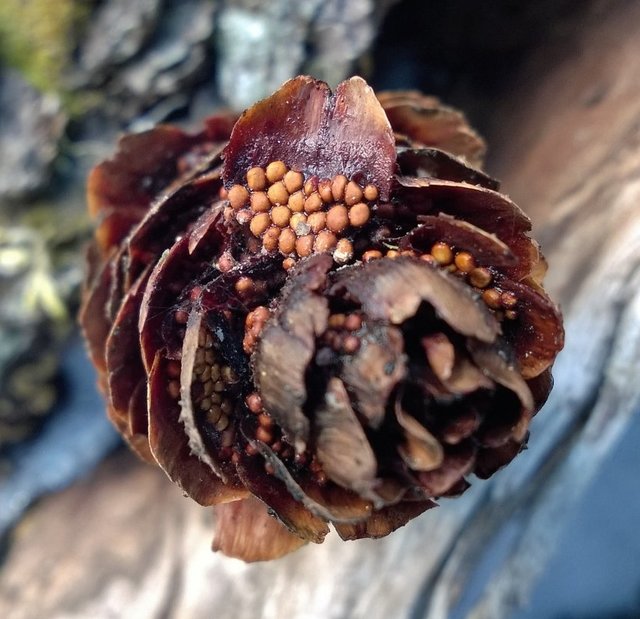
Description
The genus Puktsiniastrum includes a couple of dozen rust fungi, the main or intermediate host plants of which, along with spruce, are representatives of the families Piridae, Orchidaceae, Rosaceae and Heather. In the case of puktsiniastrum spotted, these are representatives of the genus Prunus - common cherry and antipka, sweet cherry, house plum, blackthorn, bird cherry (common, late and virgin).
The life cycle of the spotted pucciniastrum, like all rust fungi, is quite complex, consisting of several stages at which different types of spores are formed. In spring, basidiospores infect young cones (as well as young shoots). The mycelium of the fungus grows along the entire length of the cone and grows into the scales. On the outer surface of the scales (and under the bark of the shoots) pycnias form - structures responsible for fertilization. They form pycniospores and a large amount of strong-smelling liquid. It is assumed that this liquid attracts insects, which thereby participate in the fertilization process (this is the case with a number of other rust fungi).
In summer, already on the inner surface of the scales, ecias are formed - small formations, similar to slightly flattened balls. They can cover the entire inner surface of the scales and thus prevent seed setting. The spores that form in the eciospores are released the following spring
It is this stage of the life of the pukziniastrum that attracts the attention of lovers of “quiet hunting”, because the cones covered with rusty-brown grains look quite exotic
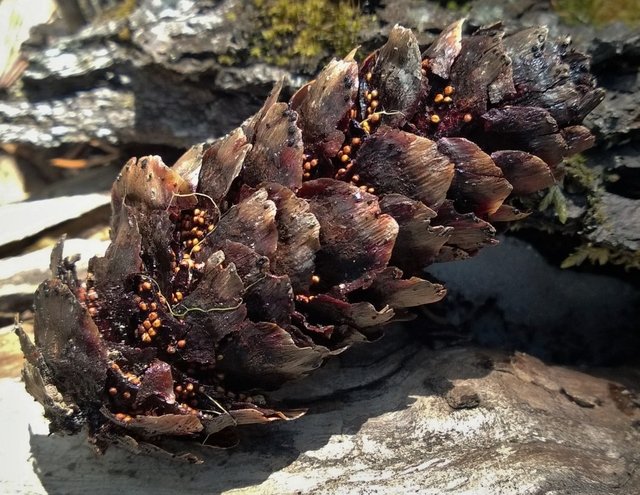
Puktsiniastrum speckled spends the next stage of its life, for example, on a bird cherry. Eciospores formed in spruce cones infect leaves, on the upper side of which purple or reddish-brown spots of an angular shape are formed (the affected area is always limited by leaf veins) with rusty-yellow convex spots in the middle - uredinia, from which urediniospores are dispersed. They infect the following leaves, and this happens throughout the summer.

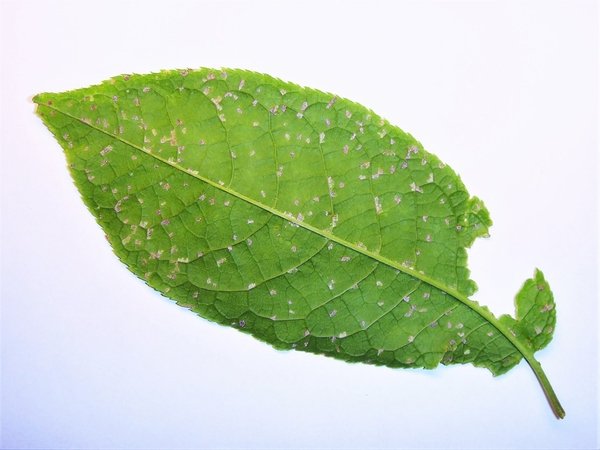
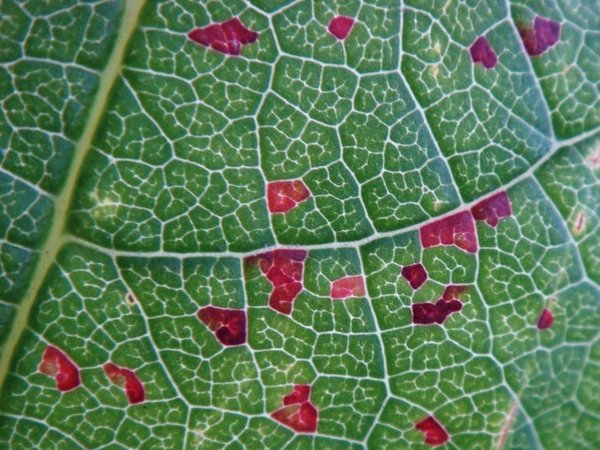
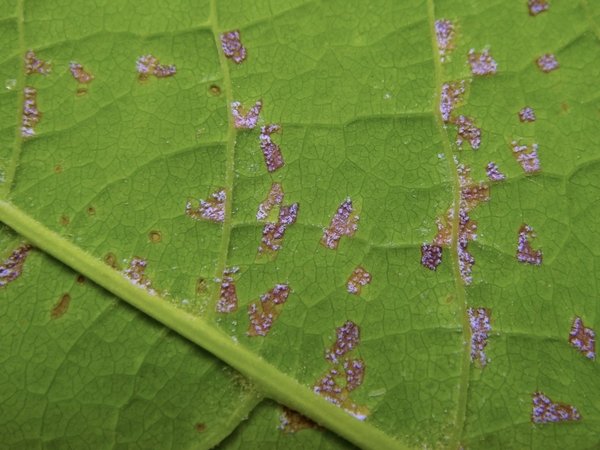
In late summer and autumn, more durable structures are formed - telia, which overwinter in fallen leaves. The spores that are released next spring from overwintered telia are the very basidiospores that are to populate the next generation of young spruce cones.
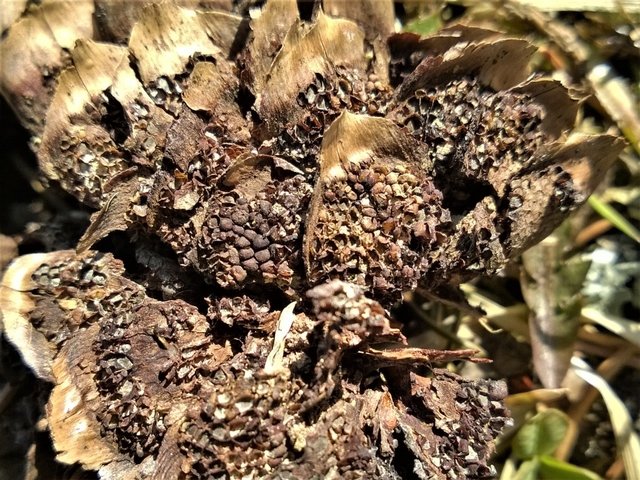
Caring for chionodox in the garden
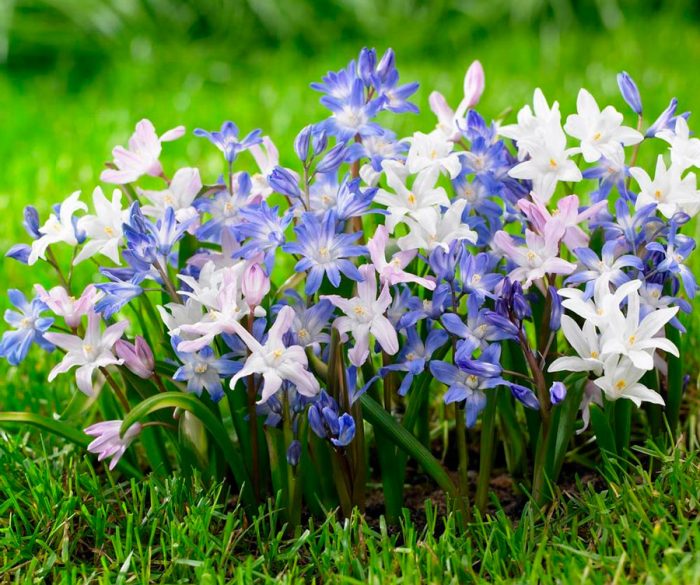
Chionodoxes of all primroses are the most unpretentious and undemanding to care for, so even novice gardeners can grow them. Watering these plants is necessary only when the winter time turned out to be little snow, and the spring time was dry. After the flowers are watered, it is necessary to loosen the surface of the soil around them, while pulling out all the weeds. Sprinkle the surface of the site with a layer of mulch (dry peat or humus) and then the amount of weeding, loosening and watering will be significantly reduced.
Also, these plants require systematic feeding and transplanting, and chionodoxes should also be sprayed with special agents for diseases and harmful insects, if necessary. To exclude the reproduction of this culture by self-seeding, all testes should be regularly cut off before they have had time to ripen.
How to water and feed
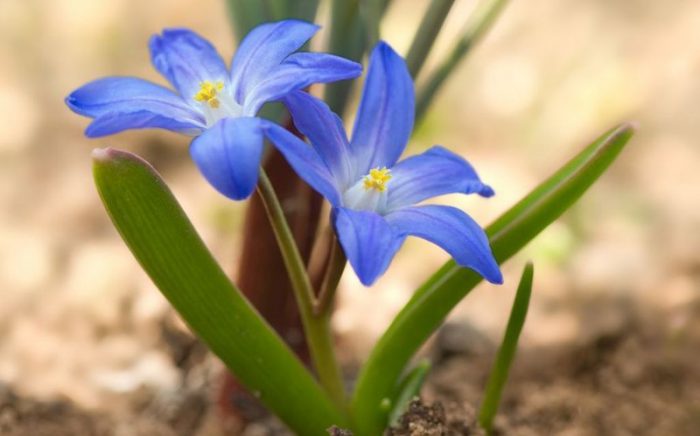
If there is a prolonged dry weather, then chionodoxes need to provide systematic and sufficiently abundant watering. Water the plants early in the morning, while trying to keep water droplets away from the flowers. Water for irrigation is used settled and not cold.
Such a plant is fed with complex mineral fertilizers.For example, you can take Nitroammofoska, it is introduced into the soil in early spring, which contributes to long and abundant flowering. If the fertilizers are granular, then they must be evenly distributed over the surface of the site, and after that the soil is slightly loosened, as this will significantly accelerate the entry of nutrients into the plant root system.
How to transplant and propagate
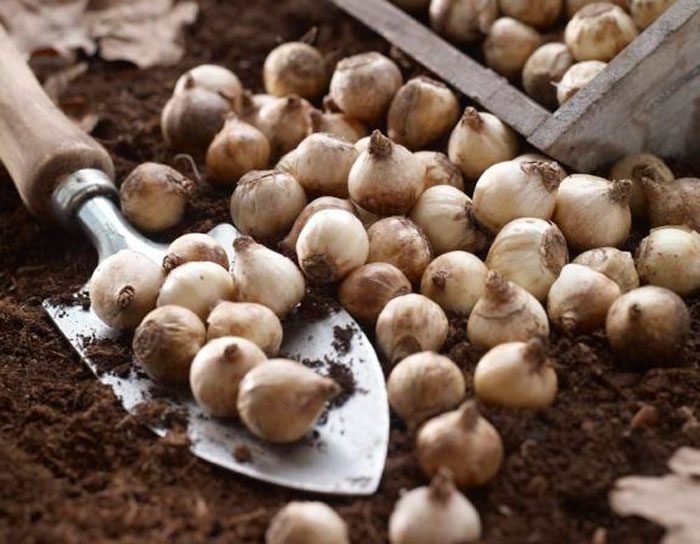
The easiest and fastest way to propagate such a plant is by children, which need to be separated from the parent plant. For 1 season, 2-4 children grow up in one bush.
Chionodoxes can grow in the same place without transplantation for about 10 years. However, experienced gardeners recommend removing nests from the soil 1 time in 5 or 6 years, dividing them and planting them. The bulbs should be dug from mid to late July, at which time the aboveground part of the bush should turn yellow and dry out. The bulbs are planted in open soil in the last days of August or the first - in September, before planting, the dug nests are placed in storage in a dark, dry and cool (from 15 to 17 degrees) place. After the nest is removed from the soil, it is not recommended to separate the children from it, because the smallest of them will most likely die before disembarking. It is better to do the division of the nest before directly planting the bulbs in the soil.
If chionodoxes are already growing on your site, then there is no need to grow them from seeds, since these flowers reproduce very well by self-sowing. The seeds have a fleshy formation that ants simply adore. Therefore, they take seeds and carry them a fairly decent distance. Plants grown from seeds begin to bloom for the first time after 2 or 3 years.
Wintering
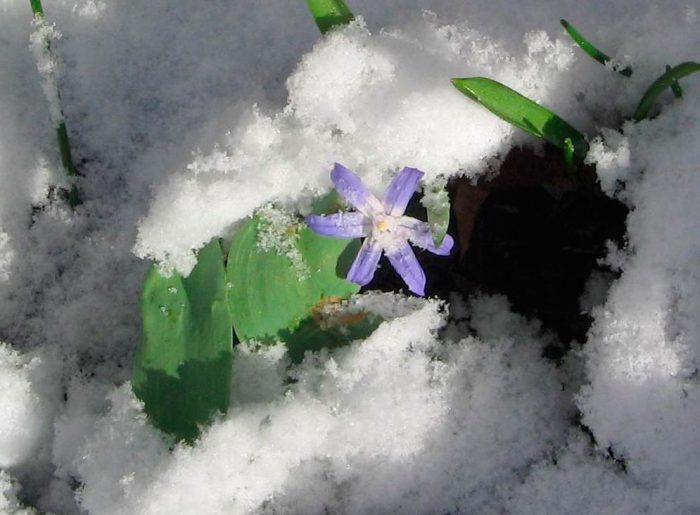
When the plants have faded, all arrows will need to be removed from them. The foliage is not touched, it is cut off only after wilting (in the second half of July). This flower is very resistant to frost. But if it grows in your open area, then in late autumn its surface should be covered with spruce branches or a thick layer of fallen leaves. In regions with a mild climate, the plant does not need shelter in any case.
Diseases and pests
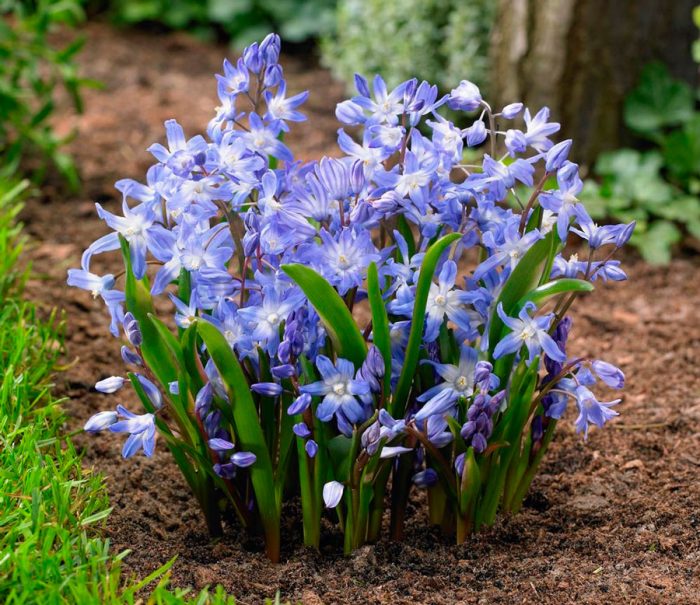
Chionodox is a bulbous culture and is therefore susceptible to diseases such as sclerotiniasis, septoria, gray rot, fusarium and achelenchoides. These diseases, as a rule, damage the bulb itself, which is hidden from the eyes of the gardener by the earth, and he learns that the plant is affected only when the bush turns yellow, withers and it is no longer possible to change something. In this regard, before planting, the etching of the bulbs is a mandatory measure; for this, a Fundazol solution is used. Also, for the purpose of prevention, liquid should not be allowed to stagnate in the soil, as this can lead to rot on the bulbs, so you need to water the flowers sparingly.
The most dangerous of all pests for this culture are the larvae of the root meadow mite, as well as rodents. They are also capable of injuring the bulb. To get rid of ticks, the bush should be sprayed with acaricide (Aktara, Akarin, Aktellik, Agravertin, etc.). And you can clear your area of moles and mice by spreading bait with poison in several places.
9. Varieties:
9.1 Calla Picasso
Plants of this variety reach a height of 60 cm and have characteristic bright purple or burgundy bedspreads with a white edge. The leaf blades are dark green, with characteristic white thin strokes on the surface. Flowering occurs in the second half of summer or even the beginning of autumn.
9.2 Calla Black Star
A beauty with a rather exotic appearance - tall, dark, almost black bedspreads tightly rolled into a funnel contrast perfectly with bright green leaves. The surface of the leaf blades has small white specks or dots, and the edges of the leaves are painted in a rich burgundy hue. Plants reach a height of 40 - 50 cm.
9.3 Calla Cantor
The variety is distinguished by burgundy, very dark bedspreads and inflorescences with burgundy flowers. The leaf blades are light green, covered with white specks and streaks.Plants can reach a height of 60 - 70 cm.
9.4 Calla Captain Safari
Medium-sized bushes reach a height of 50-60 cm and during the flowering period show bright orange-colored veils with reddish edges. The flowering period begins in the second half of summer and lasts for 1 month.
9.5 Calla Paco
A distinctive feature of the plants of this variety is the presence of large, funnel-shaped bedspreads, painted in a purple or burgundy shade with a glossy surface. During the flowering period, which occurs in the summer months, the plants give off a pleasant aroma. The height of the bushes is about 70 cm.
9.6 Calla Amethyst - Ametist
The variety has bright purple-colored bedspreads, while the inflorescences remain orange and contrast perfectly with the bedspreads. Plants are compact and do not exceed 35 cm in height. Flowering occurs in the second half of summer.
9.7 Calla Chameleon - Zantedeschia Cameleon
Low perennials, reaching 50 - 60 cm, have glossy, green leaves and brightly colored bedspreads. It is interesting that, when unraveling, the bedspreads are painted in the center in an orange tint, and at the edges they have a reddish color. As the bloom fades, the bedspreads become a single color - peach. Flowering occurs in the summer months.
9.8 Calla Schwarzwalder
Another eminent variety with dark colored, almost black, glossy bedspreads. Plant height is 45 - 60 cm, buds are formed in July.
9.9 Calla Flamingo
Delicate plants with glossy, light green leaves and pink bedspreads. The beauty of the bedspreads is emphasized by orange inflorescences.
9.10 Calla Vermeer - Zantedeschia Vermeer
Bushes reach a height of 50 - 60 cm, have dark green leaves with rich white specks. During the flowering period, which falls in the second half of summer, the plants adorn themselves with yellow, fragrant inflorescences and purple bedspreads with a white edge.
9.11.Calla Avalange - Avalanche
Tall plants, can reach a height of 80 - 90 cm. The variety is often grown on an industrial scale, as it is widespread among florists. Plants do not lose their attractiveness for a long time when cut. Bushes are distinguished by dark, green, glossy, monochromatic leaves. The inflorescences are bright, orange, wrapped in a white blanket.
9.12 Calla Treasure
This variety is often grown indoors, as it has a relatively modest size and bright appearance. In height, the bushes do not exceed 30 - 35 cm, at the beginning of summer they form orange inflorescences wrapped in bedspreads of a delicate peach shade.
9.13 Calla Sunshine - Sunshine
The dark green leaf blades of this variety are covered with white strokes and contrast perfectly with the bright yellow bedspreads. Plants reach a height of 40 - 60 cm and bloom in the middle of summer.
9.14 Kalla Samur
The main distinguishing feature of these plants are large, pale pink bedspreads, surrounding yellow inflorescences - cobs. The height of the bushes reaches 40 - 50 cm.
9.15 Kalla Solfatare - Zantedeschia Solfatare
Varietal plants reach 45-60 cm in height and form bright golden-yellow bedspreads during the flowering period.
You may also be interested in:
Melanogaster ambiguus
Synonyms:
- Octaviania ambigua
- Argylium liquaminosum
- Melanogaster klotzschii
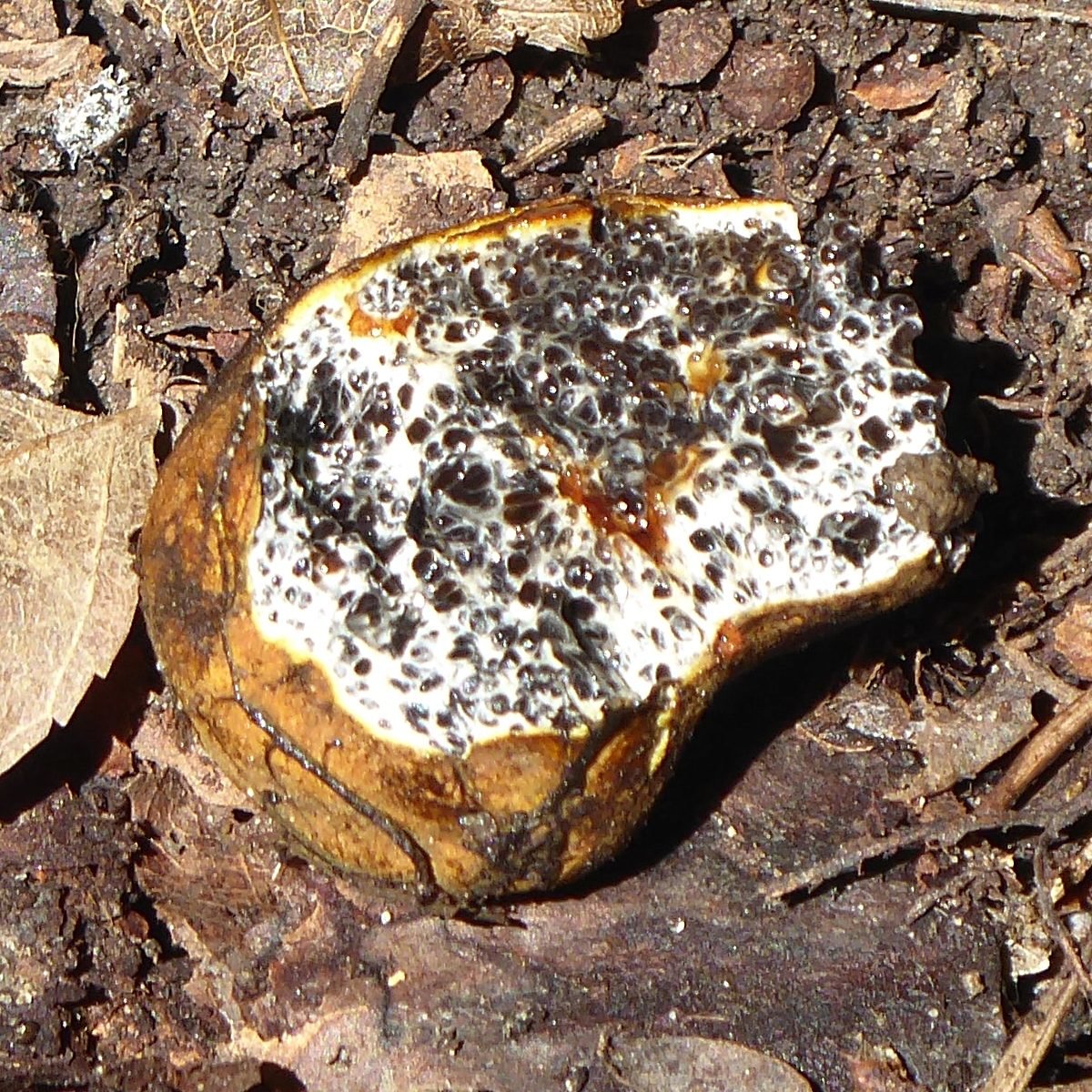
Description
The fruit body is a gasteromycete, that is, it is completely closed until the spores are fully ripe. In such mushrooms, not a cap, a leg, a hymenophore are isolated, but a gasterocarp (fruiting body), peridium (outer shell), and gleba (fruiting part).
Gasterocarp 1-3 centimeters in diameter, rarely up to 4 cm. Shape from spherical to ellipsoidal, can be regular or with irregular swellings, usually not divided into segments or lobes, with a soft rubbery texture when fresh. Attached by thin, basal, brown, branching mycelium cords.
Peridium is dull, velvety, at first grayish-brown or cinnamon-brown, with age it becomes yellowish-olive, with dark brown “bruises” spots, blackish-brown in old age, covered with a small whitish bloom. In young specimens, it is smooth, then cracks, cracks are deep, a naked white tram is visible in them. In section, the peridium is dark, brownish.
Gleb is initially white, whitish, whitish-yellowish in color with bluish-black chambers; chambers up to 1.5 mm in diameter, More or less regularly spaced, larger towards the center and base, not labyrinthoid, empty, gelatinized with mucous contents. With age, with the ripening of the spores, the glebe darkens, becomes reddish-brownish, black with whitish veins.
Smell: in young mushrooms, it is perceived as sweetish, fruity, then becomes unpleasant, reminiscent of rotting onions or rubber. An English-language source (British truffles. A revision of British hypogeous fungi) compares the smell of an adult dubious Melanogaster with the smell of Scleroderma citrinum, which, according to descriptions, resembles either the smell of raw potatoes or truffles. Finally, mature specimens have a strong and fetid odor.
Taste: young mushrooms have a spicy, pleasant
Spore powder: black, slimy.
Under the microscope
Tram plates are white, very rarely pale yellowish, thin, 30-100 microns thick, tightly woven, hyaline, thin-walled hyphae, 2-8 microns in diameter, not gelatinized, with clamping joints; there are few interhyphalic spaces.
Spores 14-20 x 8-10.5 (-12) μm, initially ovoid and hyaline, soon turning into a fusiform or rhomboid shape, usually with a subacute apex, translucent, with a thickened wall from olive to dark brown (1-1, 3) μm), smooth.
Basidia 45-55 x 6-9 µm, oblong-brown, 2 or 4 (-6) spore, often sclerotized.
Season and distribution
It grows on soil, on litter, under a layer of fallen leaves, and can be significantly submerged in the soil. Recorded in deciduous forests with a predominance of oak and hornbeam. Fruiting from May to October throughout the temperate zone.
Edibility
There is no consensus here. Some sources indicate Melanogaster as doubtful as a uniquely inedible species, some believe that the mushroom can be eaten as long as it is young enough (until the gleba, the inner part, has darkened).
No data on toxicity could be found.
The author of this post adheres to the principle of "not sure - do not try", so we will carefully classify this species as an inedible mushroom. Photo: Andrey
Photo: Andrey.

